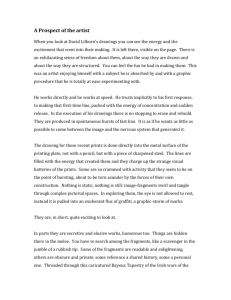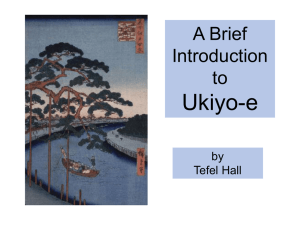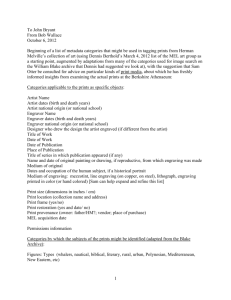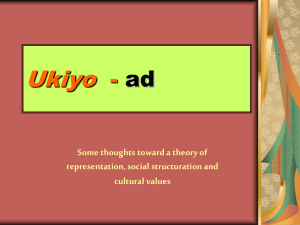Tin House (Issue 29, Graphic Issue), Feature
advertisement
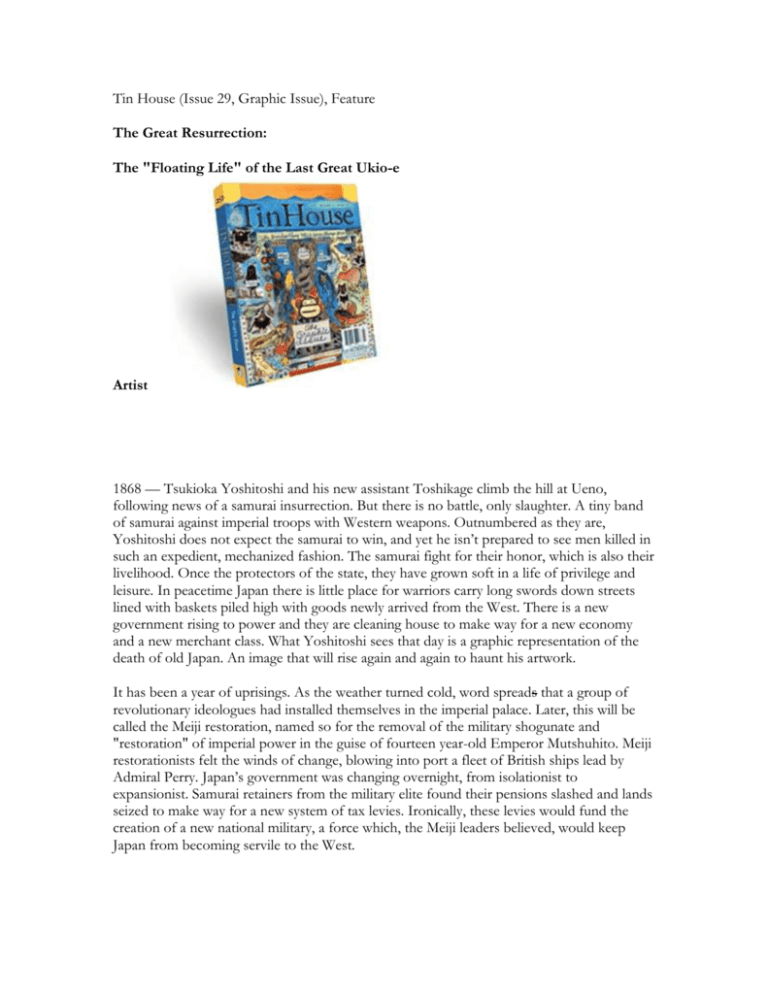
Tin House (Issue 29, Graphic Issue), Feature The Great Resurrection: The "Floating Life" of the Last Great Ukio-e Artist 1868 — Tsukioka Yoshitoshi and his new assistant Toshikage climb the hill at Ueno, following news of a samurai insurrection. But there is no battle, only slaughter. A tiny band of samurai against imperial troops with Western weapons. Outnumbered as they are, Yoshitoshi does not expect the samurai to win, and yet he isn’t prepared to see men killed in such an expedient, mechanized fashion. The samurai fight for their honor, which is also their livelihood. Once the protectors of the state, they have grown soft in a life of privilege and leisure. In peacetime Japan there is little place for warriors carry long swords down streets lined with baskets piled high with goods newly arrived from the West. There is a new government rising to power and they are cleaning house to make way for a new economy and a new merchant class. What Yoshitoshi sees that day is a graphic representation of the death of old Japan. An image that will rise again and again to haunt his artwork. It has been a year of uprisings. As the weather turned cold, word spreads that a group of revolutionary ideologues had installed themselves in the imperial palace. Later, this will be called the Meiji restoration, named so for the removal of the military shogunate and "restoration" of imperial power in the guise of fourteen year-old Emperor Mutshuhito. Meiji restorationists felt the winds of change, blowing into port a fleet of British ships lead by Admiral Perry. Japan’s government was changing overnight, from isolationist to expansionist. Samurai retainers from the military elite found their pensions slashed and lands seized to make way for a new system of tax levies. Ironically, these levies would fund the creation of a new national military, a force which, the Meiji leaders believed, would keep Japan from becoming servile to the West. 1869—Although the fragile economy keeps commissions to a trickle, Yoshitoshi’s skills as an artist are beginning to be recognized. He is named one of the top five woodblock artists in Japan. The form is an exacting one, requiring a measure of deftness and passion to bring the wooden lines to life. Each print is unique, representing the work of many hands in the studio. Yoshitoshi wanders the streets for material to create the first, detailed sketch, getting the motion of wind through heavy robes, the curling toes of a man readying for a fight. Often Yoshitoshi paints his subjects nude to get the anatomy right, later adding the many layers of robes that are in fashion. Back in the studio he works with the printmaker to carve the woodblocks and lay on each color separately. Yoshitoshi’s early work is not technically superior to that of his peers,’ but it has a peripatetic passion and love of gore that initially makes it very popular. He will continue to be fascinated by gory prints, one of the most famous being The Lonely House on Adachi Moor— in it a woman hangs from the ceiling of a tiny shack, anchored by a thick cord of rope tied around her feet. Her mouth is gagged and her hands tied behind her back. She is naked, her joints swollen, and sweat drips into her eyes. An old, emaciated woman stands beneath her, naked to the waist and holding a huge knife. The bound woman pleads with her, eyes rolling back in her head. She is hugely pregnant and her belly sags toward the old woman like ripe fruit. One hundred years later, Akutagawa Ryunosuke, upon whose short story Akira Kurosawa’s classic 1950s film Rashomon is based, will view an exhibit of Yoshitoshi’s early work and will be unable to sleep for six weeks afterward. It is not just Ryunosuke’s avid imagination that makes the prints seem haunted. Yoshitoshi’s early work is evidence of a deeper disturbance in Japanese culture and in the mind of the artist himself. 1871—A face appears in Yoshitoshi’s imagination like the moon above a dark sea. She is openly weeping and yet wary, unable to abandon herself to the grief he knows she must feel. He looks down at his nails, artist’s hands too soft for manual labor now growing knobby as wood. He worries a splinter from his palm. Next to him, Okoto continues pulling up floorboards for heat. There’s no money for firewood and he wonders if they can get the fire hot enough to boil water for rice. He knows he should be working, but doesn’t know where to start. The sight of the once famously beautiful Okoto on her knees in brown robes does nothing to cheer his imagination. Her silk robes, blooming with gardenias and turquoise vines, have been packed away like gardens under hoar-frost, sold to a traveling vendor at a cut rate. Yoshitoshi can’t work. He can hardly eat, so why worry about the rice? Except that Okoto has become grossly swollen from hunger. Perhaps some demon has impregnated her. She begged him again this morning to see a doctor, but even a madman knows there’s no cure for madness. Besides, his back still aches from the moxibustion treatment, a row of pustules pocking his spine like cigarette burns. Tsukioka Yoshitoshi is thirty-two, and this is the first flush of a recurring madness that will ultimately kill him. An artist already of some renown, he has weeks of normalcy when he can leave the house to sketch a subject or deal with patrons, but then always the inevitable slide into darkness. The sight that greets Yoshitoshi on the streets is no more encouraging than the horrors at home, though those are of his own making. At night he escapes to the geisha houses, where he is greeted as an old friend. Quickly, however, the talk turns to politics—the rise of the new government cutting a seam through Japan from ear to ear. As if he is using delicate stitches to seal a large, open wound, Yoshitoshi tries unsuccessfully through his art to hold old and new Japan together. The woodblock form he uses is well-respected but quickly being replaced by Western lithographic techniques. Yoshitoshi has mastered an art that everyone says is dying. No one will buy his painstaking prints. Economic and social pressures mount in an already unstable brain, until Yoshitoshi takes finally to his bed. He creates no new work for almost a year. 1873—Yoshitoshi leans over the printmaker’s shoulder as the man pastes his design onto a block of fine-grained cherry wood. The printmaker selects a gauge and begins to carve away the white space, making deep grooves on either side of the lines. When Yoshitoshi is satisfied that the printmaker is being faithful to the smooth, calligraphic stroke of the artist’s brush, he rises and returns to the front of the studio, where several apprentices crouch over boards and brushes. One in particular, Yoshitoshi’s first apprentice Toshikage, has developed an especially fine style. Yoshitoshi’s initial madness left him impoverished, but when he began working again he realized that his new style was bringing more and more patrons to his studio. Yoshitoshi’s primary genre is Ukiyo-e, a popular art form that depicts prostitutes, geisha, gangsters, and life in the pleasure quarters. The newly emancipated merchant class is hungry to acquire the culture they can now afford, but the content of Ukiyo-e prints has become stale, depending on cliché to impart its meaning. The public is sick to death of falling cherry blossoms. Yoshitoshi responds by creating something that succeeds in tying traditional themes together with a modern look. He begins depicting characters and scenes with a degree of psychological realism that gives them a powerful emotional impact. Because of government censorship prohibits images of officials currently in power, Yoshitoshi depicts heroes from Japanese and Chinese mythology. This helps ignite the imagination of a populace already beginning to see the Samurai as romantic icons of rebellion. Yoshitoshi’s Finest Warriors is his first series under the new name "Taiso" Yoshitoshi, which means "the great resurrection." Instead of showing the bloody moment of violence, Yoshitoshi imagines the moment before or after an event and how it weighs on the mind of a central figure. In one powerful print, an old samurai is about to commit seppuku, but instead of illustrating the sword in his belly, Yoshitoshi shows the old man breaking his cup against the wall. It is an image full of violence, though none is actually shown (except against the teacup). But it clearly shows that despite tradition, obligation, and honor, the old samurai does not want to go. Behind him, black waves, edged with mica in the final print, thrash against the side of the house. Commissions are pouring in, and though the studio puts out hundreds of prints a week, the demand is often more than they can handle. One afternoon, Yoshitoshi receives word that a wealthy patron is en route to his studio to check on the progress of a commission. When the patron arrives he is shocked to see that Yoshitoshi has tied his assistant Toshikage to thick supporting beams and is standing in front of him with a set of awls and a hammer as though about to crucify him. Terrified, Toshikage pleads with the patron to be cut down. When they finally convince Yoshitoshi to relent, the patron hurriedly makes an excuse and runs home. Yoshitoshi begins laughing. He informs Toshikage that they now have at least two more weeks to work on their design. 1874 — On the streets, samurai rebellions continue to flare up against the new land tax and conscription laws. As part of a regimented plan to prepare Japan to meet the West, the Meiji government declares Japan will switch to a Gregorian calendar, abandoning their lunar, agrarian calendar. The government considers declaring Christianity the official religion but settles on Shintoism, banning all Buddhist art and text. In the midst of the upheaval Yoshitoshi finds lucrative work for a newspaper, creating illustrations of the battles for a news-hungry public. 1877 — The needle is remarkably like the gauge. The tattooist pushes the needle into the man’s back, unerringly accurate with the long bamboo rod. The man’s back weeps ink, and the tattooist wipes it away with a motley rag. The hero is one of the gangster Suikoden, Robin-Hood types hailing from the most impoverished areas who maraud at night through the estates of wealthy landowners. The Suikoden tales originate in China, but are embraced by the Japanese as populist superheroes and incorporated into Japanese mythology. They are men like Shi Jin, once a wealthy serf who captured a band of rebels while protecting his land but was so moved by their tale of oppression that he left his house to join them, becoming Kumonryu, or "nine-dragoned," for the nine dragons coiling in red, green, and black tattoo over his back. These full-back tattoos are called irezumi, incorporating a bestiary of mythological creatures that are supposed to protect the wearer from harm. Once marked, he will always be a rebel. Men and women with tattoos are banned from public bath-houses and feared as Yakuza, the Japanese mafia. 1877 is Yoshitoshi’s most productive year, also his most manic. He is successful, has a new girlfriend, is by all appearances at the top of his game. Yet every night he visits the pleasure district, spending his commissions faster than he can get them. He is especially fond of a geisha named Maboroshidayu, who one night threatens to charge Yoshitoshi the astronomical sum of 100 yen for "unspeakable acts performed on her body." 1878—Everyone is a little drunk. Yoshitoshi sits by the fire, a cup of sake warming in his hands. A spark popping from the hardwood lands him on his ass and the laughter in the room is a little too loud. The flute music stops for a moment and then resumes. The colors are too bright, reflecting in a drunkard’s eyes like the new, bright aniline dyes just imported from the West. Yoshitoshi is celebrating a commission to do a new series of Bijin-e, or Beautiful Women prints, and he looks forward to incorporating these bright new colors into the traditional robes of his women. The reds especially make lewd-looking under-robes, flashing from beneath floral brocades like the concealed parts themselves. When the musician stops playing, he stands quiet as a specter, waiting to be paid. His presence becomes more and more ominous as everyone in the room realizes that Yoshitoshi has no money left from his new commission. Toshikage, fearing his master’s embarrassment, runs down the street to rousts his father out of bed. Toshikage’s father gives him money to pay the musician but not before remarking what an unrequited ass his master is. Oraku, the hostess, sees the guests out the door, standing even taller than usual, her oiled hair falling to her hips, making up for the dull brown robes she wears. As the guests file out, one remarks that Yoshitoshi strips his women naked before casting them out on the street. Along the Ginza river patrons straggle home from pleasure houses in the predawn light, tired as damp rags wiped over the marbled sky. It is the life of Ukiyo-e to take pleasure where you can and not to take the suffering world too hard. The term Ukiyo-e means "the floating world" and is a play on the Buddhist term for "the suffering world." According to Buddhist thought, the suffering world is the mortal one and our pains are compounded by striving vainly to satisfy our desires. But while freeing oneself of desire is a major tenant of Buddhism, the Ukiyo-e lifestyle seeks to bob on the surface, keeping one’s pleasure aloft for as long as possible. Living only for the moment, turning our full attention to the pleasures of the moon, the snow, the cherry blossoms, and the maple leaves; singing songs, drinking wine, diverting ourselves in just floating, floating, caring not a whit for the pauperism staring us in the face, refusing to be disheartened, like a gourd floating along with the river current; this is what we call the floating world. --From the novel Tales of the Floating World (Kayo Monogatari) by Asai Ryoi (1612-1691)1881 Every block of color is a separate block of wood. When Yoshitoshi designs twelve robes, there is a block for each robe, as well as a separate block for each pattern. The women’s skin is left blank, its creamy whiteness coming from the fine quality of the paper itself. In this design, a man is the central figure, his robes black and heavily padded. The deep red stamp on his back identifies him as part of Troop Number One; in his left hand he holds the standard of his brigade, a signal in the great conflagration that he is still alive. Many times he will rise to see a flag fall, the crack resounding above the rush of air like a branch broken. Into a darkening sky the moon rises, partially obscured by smoke. The gradation of smoke and fire on each print is created by hand, by softly wiping the color from the block. Popping ashes are achieved by spattering gofun, a lime mixed with chalk or sea shells and glue, onto every wet print. Yoshitoshi uses a similar technique to give the blood in his gory prints a congealed quality, but employs it now to show the closeness of the blaze to his Edo no Hana, or Flower of Edo, as the firemen are sometimes called. We see the fireman from behind, contemplating the danger before going in. The only visible human element is his tumescent palm, fingers curling away from the blaze. This image is from Yoshitoshi’s masterwork, One Hundred Aspects of the Moon. The series is in part a tribute to the traditional lunar calendar, but also it captures the twilight realm between old and new. In this series Yoshitoshi’s artistic skills are at their height. One Hundred Aspects of the Moon is a series of one hundred prints linked by the depiction of the moon, from a gibbous hemisphere filling two-thirds of the page to merely the shadow cast by moonlight. Yoshitoshi’s style has changed with his content, and with the times— focusing on dynamic shapes that draw the eye to particular details and broad panels of color that will later inspire art-nouveau artist Toulouse-Lautrec and many Western printmakers. Yoshitoshi’s flat dramatic style emphasizes his confident lines and uses size to create perspective— a method that will be a key ingredient in Van Gogh’s transformation into an impressionist artist. The impact of Yoshitoshi’s prints is immediate, but they also draw the viewer in to follow a deeper narrative. Yoshitoshi’s success with One Hundred Aspects of the Moon inspires his contemporaries to take new interest in traditional narratives. Despite a fascination with new Western techniques and dyes, Yoshitoshi is a member of a traditionalist group that seeks to preserve traditional Japanese culture and art in the midst of a seismic cultural shift. However, good art can never be static, and were it not for Yoshitoshi, Ukiyo-e could have died with a whimper. His dedication to the archaic woodblock form, his passionate desire to express cultural and personal uncertainties and his imaginative use of new perspectives make the old form come alive. Yoshitoshi’s art is a bridge between the old and new, inspiring the next generation of Eastern and Western artists to look to traditional Japanese art as a way to express modern sensibilities. Postmodern Japan is a system without structure floating on a flow of bits of mass-information… Japan's post-historical historicity is not based on anything, but floats on its own self-referential loop which defies any attempt at historical construction. -- Inaga, Shigemi, "To Be a Japanese Artist in the So-Called Postmodern Era.," 1892 — Yoshitoshi’s success as an artist does not soothe his unrest, or that of suddenly modern Japanese society. At the age of fifty-three, plagued by the paranoia and depression that had caused his earlier breakdowns, Yoshitoshi again takes to his bed with a brain fever and does not rise again. Although today his work is not as well known as that of Hokusai, a Ukiyo-e printmaker famous for his Thirty-Six Views of Mt. Fuji, Yoshitoshi is credited with being the last great Ukiyo-e artist and the one to resurrect the style from the ashes. An artist who lived and depicted Ukiyo-e, Yoshitoshi’s work both glorifies and condemns the floating life. Even a warrior on the eve of his last great battle will stand on a promontory and wonder whether the image he sees before him is real or merely a dream, not far removed from the geisha sipping sake from a cup hidden in her sleeve, or an ageing artist who lies dreaming of escape from the suffering world but worries whether he has left a legacy.


